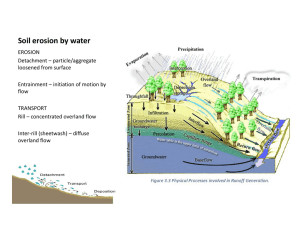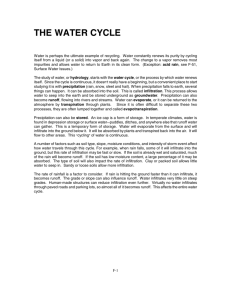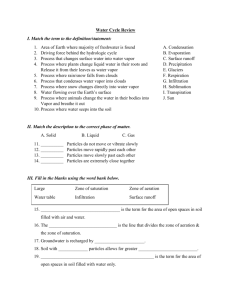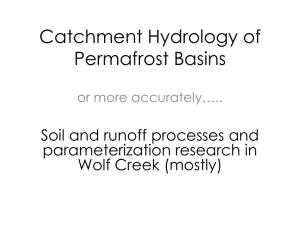Hydrological Processes and Parameterization: Infiltration and Runoff Bill Quinton, Ric Janowicz,
advertisement
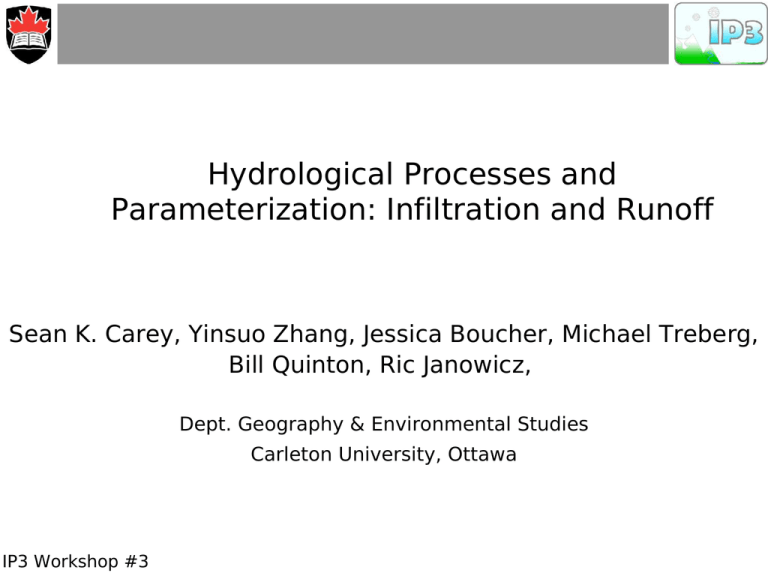
Hydrological Processes and Parameterization: Infiltration and Runoff Sean K. Carey, Yinsuo Zhang, Jessica Boucher, Michael Treberg, Bill Quinton, Ric Janowicz, Dept. Geography & Environmental Studies Carleton University, Ottawa IP3 Workshop #3 Overview Runoff – Ecosystem Controls – Transit Time Distributions – Channel Snow/Ice Infiltration – Parameterization/modelling activities HRU Classification The Wolf Creek Research Basin Location: 60o31 N, 135o 31’ W Area: Approx. 200 km2 Elevation Range: 800 to 2250 m a.s.l. (3 ecozones) Mean Annual Precipitation: 300 to 400 mm (40% snow) Mean Annual Temperature: -3 oC GB_04 2.1 km2 Stony soils, some lichen GB_03 1.5 km2 Tundra vegetation GB_02 GB_03 GB_04 GB_01 GB_02 2.9 km2 Birch dominated GB_01 1.1 km2 Willow dominated Data – Simple Hydrochemistry Last Year’s summary All HRUs contribute water to the stream in approximately equal volume. Much greater deep groundwater flow than previously reported or anticipated. Work ongoing to assess seasonal dominance of HRUs (logistics). Role of channel ice/snow to be investigated Hillslope Runoff – Energy Dynamics 2 5 A p r i l 3 0 A p r i l 1 7 0 50 m 9 M J u a n y e snow-covered, no subsurface flow 1 00 0 10 20 30 cm (thaw depth) 363 158 5 1.8 m d (Kf ) low Ks High Ks transition -1 Hillslope Runoff – Energy Dynamics 2 5 A p r i l 3 0 A p r i l 1 7 0 50 m 9 M J u a n y e snow-covered, no subsurface flow 1 00 0 10 20 30 cm (thaw depth) 363 158 5 1.8 m d (Kf ) low Ks High Ks transition -1 Transit/Residence Time Distribution Residence Time: time (since entry) that a water molecule has spent inside a flow system McGuire et al. 2005 Residence Time Assumptions Convolution integral McGuire et al. 2005 Weighed recharge (a must!) Convolution integral Weighed recharge (a must!) Inputs – tough with lots of assumptions Use Whitehorse δ 18O curve for post-melt period No input after October to melt Observed meltwater δ and volume “flow weighted” O 18 Outputs - messy! Lag times need to be adjusted if considering rainfall versus snowmelt (may want to consider only melt signatures or rain/melt separately) Parameter converge does occur (GLUE), yet N-S goodness of fit “mediocre” ~0.6 to 0.7 Mean Residence Times fast compared with temperate catchments (<2 months) – the melt signature strongly influences the result. Utility of SpC and other high-frequency data Development of a SpC budget as a way forward (stronger and cleaner signal) SpC, while not conservative, has a strongly weighted snowmelt signature RTD can be further assessed using runoff models at event-scale and tracer data Off to Aberdeen in February for advice. The Role of Channel Ice and Snow – What is the role of icing and channel ice? Simulation of infiltration into organic-covered permafrost soils Evaluate several commonly used infiltration algorithms using filed measurements at several organic covered permafrost sites Identify the key parameters/processes in infiltration simulations at organic covered permafrost soil. Provide guidelines for the implementation of appropriate infiltration algorithms/parameters in hydrological and land surface models Tested ( Empirical & analytical Numerical Mixed (analytical+ numerical) ) Infiltration Algorithms Gray et al. (1985) SWE based empirical relation INF = 5(1 − S I ) SWE 0.584 Zhao and Gray (1999) parametric relation INF = CS02.92 (1 − S I )1.64 ( 273.15 − TI −0.45 0.44 ) t 273.15 Green_Ampt (1911) and various modifications INFr = K s [1 + (θ0 −θi )ψw ] F Numerical solvers of Richard’s equation or coupled heat and water transfer equations with water flux as surface boundary e.g. HYDRUS1D (Šimůnek et al., 2005), HAWTS (Zhao et al., 1997) etc. ARHYTHM Instantaneous Infiltration model (Zhang et al., 2000) (TopoFlow) SHAW infiltration - modified Green_Ampt Approach for Muti-layered soil (Flerchinger and Saxton, 1989) Determination of input/output variables from field observations Ground surface temperature (T0) -- Observed surface or near surface temperature Snow-melt (Msn) and rainfall (R) --Scotty Creek: daily SWE observation and tipping-bucket rain gauge --Wolf Creek: daily snow depth with in situ snow density samples and tipping-bucket rain gauge Evapotranspiration (ET) --Site calibrated Priestley- Taylor (1972) Infiltration (ΔSWliq /ΔSWtotal : liquid / total soil water changes; SWmelt : soil ice melt) --Scotty Creek: INFest = ΔSWliq – SWmelt +ET (if positive) --Wolf Creek: INFest = ΔSWtotal +ET (if positive) Runoff --Scotty Creek: Runoffest = R + Msn + SWmelt - ΔSWliq - ET (if positive) --Wolf Creek: Runoffest = R + Msn - ΔSWtotal - ET (if positive) Wolf Creek Simulations: control variables, thaw depth, infiltration and runoff Wolf Creek: Soil Moisture Simulations and Observations - Liquid: TDR - Total: Gamma Scotty Creek Simulations: control variables, thaw depth, infiltration and runoff Scotty Creek: Soil Moisture Simulations and Observations - Liquid: TDR - Total: None Preliminary results and ongoing works Gray’s empirical estimation gave an acceptable estimation for cumulative endseason snow-melt infiltration at Wolf Creek, but largely underestimated the infiltration at Scotty Creek, due to the near saturated soil condition. The parametric method (Zhao et al.) worked at both sites in terms of cumulative endseason snow-melt infiltration, however it power-shaped curve did not follow the actual daily infiltration course. •Pure numerical solutions for infiltration problems require very fine time and soil layer resolutions (~minute / ~cm), hence very difficult to be applied in field applications. Mixed methods with coupled thermal and water transfer equations have the capacity to simulate the details of infiltration progresses and soil moisture dynamics in. However appropriate algorithms / parameters have to be identified for organic – covered permafrost soils. •Ongoing works for this study: --more expertise is needed in quantifying the inputs/outs from limited observations --evaluate the parameterization methods/parameters for thermal and hydraulic properties of those soils at the two sites. --Improve the current tested infiltration algorithms for organic –covered permafrost soil. Multi-Function Heat-Pulse Probes (MFHPP) •Central probe is a heater •Outer probes are thermocouples & Reflectometers •Total water is unknown, liquid is known, all other k and C values known •Inverse procedure allows determination of ice fraction •Install vertically and horizontally (to measure infiltration similar to sapflow) Multi-Function Heat-Pulse Probes (MFHPP) Image Classification Ongoing Work
